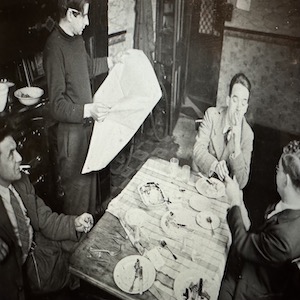Mass Observation Online
Mass Observation Online (MOO) is derived from the digitized archive of the organization Mass-Observation, a United Kingdom social research organization founded in 1937 by anthropologist Tom Harrison, film-maker Humphrey Jennings and poet Charles Madge, the aim was to document the social history of Britain by recruiting a team of observers and volunteers to write about their lives and opinions. There are two major types of studies in the collection: material collected by paid investigators and material submitted by volunteers. Paid investigators carried out studies, surveys, and recorded their covert observations of others. Volunteers submitted diaries and responses to open-ended prompts. The raw data was ultimately collated to form more than 3000 file reports relating to art, drinking and smoking habits, religion, famous people, household budgeting, world outlook, and reading habits. This resource covered the original Mass Observation project, the bulk of which was carried out from 1937 until the mid-1950s, offering an unparalleled insight into everyday life in Britain during these transformative years.
The home page lists five tabs at the top of the screen: "Introduction", "View Documents", "Visual Resources", "Searching Guide", and "Researching Tool." Up at screen top right, there's a Search box with links to Advanced Search beneath it. By choosing the section "View Documents," users can explore different collections, including diaries, day surveys, publications, topic collections, file reports, and directive questionnaires. Users can browse the collection according to date, observer's sex, observer's location, and document type. The "Visual Resources" section provides an interactive map, which plots the locations of all the diarists that featured in MOO. It also offers four exhibitions that draw upon primary source documents to highlight key visual material and provide further contextual information. Under the section "Research Tools," the "Essays" and "Editor's Choice" include a series of scholarly papers that provide first-time users with a comprehensive critical account of the contexts. The tab "popular searches" allows users to search with one click for events, keywords, organizations, people, and places which occur frequently in Mass Observation Online. The section also provides access to two Chronologies: A World War II chronology from 1939 to 1945 and an Interactive Chronology from 1937 to 1957.
The extraordinary content of Mass Observation Online, which is unique, extensive, and granular, will give students, professional historians, and the general reading public access to one of the great treasure troves of twentieth century British history. One of the great values in using MOO was not only as a mirror to wartime society or Britain of the 1950s, but also as a way of thinking about historical methodology. MO’s questionnaire of 1941 is an excellent starting point for exploring these materials. Students might be encouraged to think historically about the questionnaire. How did ordinary people in 1941 perceive both the impact of war in the present and the prospect of peace in the future? Can we see the roots of the 1945 Labor victory reflected in responses to the questionnaire? Second, we need to know that the document should not be simply read as being a clear reflection of public opinion. The questionnaire reflected class differences and was shaped by them, particularly with relation to the working-classes. Using this evidence, teachers can ask students what kinds of social criteria (class or gender) were set out in this survey and in the responses. Finally, teachers can let students realize the play or tension between its status as ‘objective’ evidence of a particular historical moment or public attitudes – a neutral vessel of documentary material, and the subjective source of this evidence. How ‘objective’ or ‘scientific’ was the technique used by MO to gather testimony? How did this affect the veracity of such evidence? What was the position of the observers? How can the peculiarities of this evidence be weighed against other source material? Those materials allow us to think about how personal and subjective accounts intersected with and differed from larger, more generalized histories of a period. For historians, what generalizations can be made from explicitly subjective accounts? How do historians have to treat such subjective accounts?
In sum, much of the charm of the archive is that it documents the history of the everyday man, woman and child not simply the often-told stories of political figures and celebrities. By exploring those materials, the Mass Observation Online makes us realize that British ordinary people were agents of history merely by going about their everyday lives. Therefore, MOO records broke the separation between the worlds of political activists and ordinary citizens and provided historical evidence which was out of the scope of either party records or newspaper accounts. The MOO materials afford us an opportunity to not only hear the voices of the past, but to think about the ambiguities of those voices.
